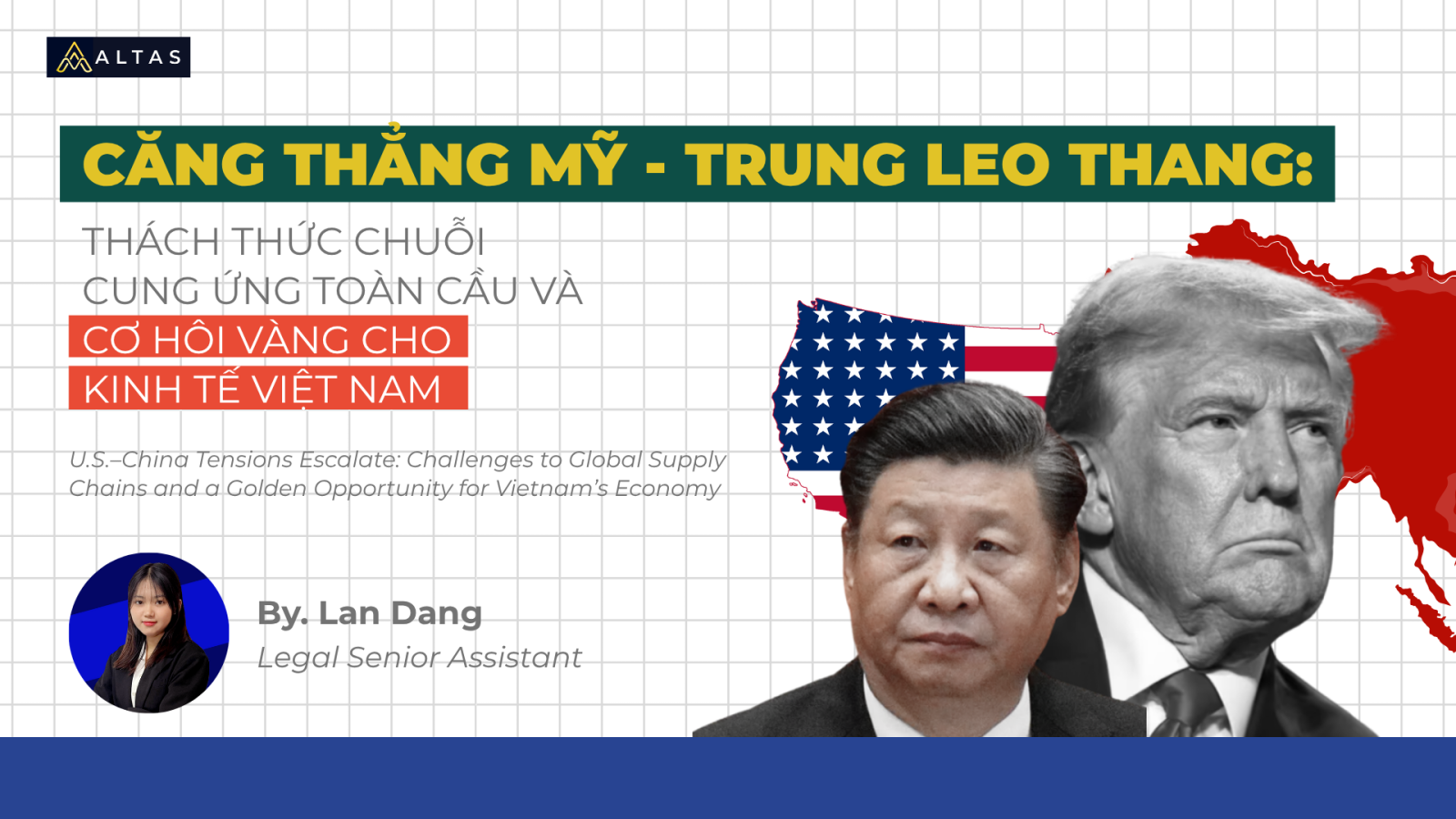U.S.–China Tensions Escalate: Challenges to Global Supply Chains and a Golden Opportunity for Vietnam’s Economy
Views: 417
HOT NEWS

Written by: Ngoc Lan
Legal Senior Assistant
Support:
Written on: 21/10/2025

1. Impacts on Vietnam’s Economy
🔹 Positive impacts (Opportunities)
a. Supply chain relocation opportunities:
As the U.S. threatens to impose a 100% tariff on Chinese goods, many companies—especially those in the electronics, components, and high-tech sectors—are seeking to reduce their dependence on China and relocate production and processing to “friendlier” countries.
Vietnam, with its geographic proximity to China, competitive labor costs, and investment-friendly policies, stands to benefit.
Many international enterprises have been increasingly “sourcing from Vietnam” as a way to diversify supply chain risks amid escalating U.S.–China tensions.
Vietnam is emerging as a new strategic hub in the reshaped network of global trade corridors.
b. FDI boost:
Investors are gradually “decoupling from China,” and Vietnam is a top candidate thanks to its preferential policies, abundant labor market, and improving investment environment.
In fact, Vietnam is witnessing significant inflows of FDI from the U.S., South Korea, Japan, and Europe.
c. Opportunities in logistics and maritime sectors:
Vietnam currently ranks among the top 10 countries by container throughput and is highly regarded by global shipping lines for its role as a regional transshipment hub.
Major seaport projects such as Cái Mép – Thị Vải, Lạch Huyện, and Liên Chiểu are attracting investors. As trade flows are rerouted from China through intermediary countries and alternative ports, Vietnamese ports could become major maritime centers, offering convenience and benefits to investors.
🔹 Negative impacts (Challenges)
a. Supply chain disruptions in raw materials and components:
If China imposes export controls on rare earths (REE) or other critical materials—as expected amid rising tensions—Vietnam’s manufacturing, electronics, battery, and semiconductor sectors could face shortages of input materials.
Moreover, stricter U.S. inspections on transshipment (Chinese goods rerouted through third countries) mean that many Vietnamese exports risk being subject to higher tariffs if they fail to meet rules of origin requirements.
b. Rising transportation costs:
Special port fees between the U.S. and China have driven global shipping rates up, significantly increasing Vietnam’s import costs for raw materials and machinery as well as export logistics costs.
For Vietnamese exporters, higher logistics costs will erode profit margins and reduce competitiveness if they cannot pass the extra costs to consumers.
c. Exchange rate and financial market volatility:
Global tensions often drive capital toward “safe havens” such as the USD and gold, while emerging markets’ currencies and interest rates become more volatile.
Additionally, investment flows—both FDI and short-term capital—may pause or withdraw if geopolitical risks rise.
Vietnam’s stock market may also be affected by global sell-offs, similar to declines on Wall Street.
2. Impacts on the Southeast Asian Region
🔹 Short-term benefits:
ASEAN countries—including Vietnam, Thailand, Indonesia, and the Philippines—can serve as intermediate destinations for production shifting out of China.
China’s exports to the U.S. fell by 27% in September 2025, while its global exports rose by 8.3%, reflecting a redirection toward ASEAN, Africa, and Latin America.
🔹 Common risks:
Many ASEAN nations still depend heavily on China’s supply chains—when these are disrupted, they also face consequences.
Intra-regional competition will intensify: countries with better infrastructure and more favorable tax policies will attract more investment, while weaker economies may lag behind.
Meanwhile, imported inflation risks (due to higher shipping and raw material costs) may spread across the region.
3. Outlook and Recommendations for Vietnam
Short term (2025): Strengthen control over the origin of goods to avoid U.S. tariff risks; diversify export markets to the EU, Japan, South Korea, and South Asia to reduce dependence on the U.S.
Accelerate investment in logistics and port infrastructure, and improve customs procedures and investment policies to attract FDI flows relocating from China.
Medium term: Develop high-tech industrial clusters such as electronics, semiconductors, and new materials; enhance regional logistics connectivity and intra-ASEAN cooperation.
Focus on technical workforce training and technology transfer in high-FDI industries.
Long term: Promote a green economy and sustainable supply chains to adapt to global trade volatility; diversify markets and maintain balanced trade relations with both the U.S. and China.
Increase domestic localization in production to reduce dependence on imported basic components.
In summary:
The U.S.–China trade confrontation over rare earths and maritime issues may disrupt short-term trade flows, but it also presents major opportunities for Vietnam to attract FDI, develop logistics, and move up the global value chain—provided the country can effectively leverage global production shifts and strengthen its internal economic capacity.
Content Moderated by
DANG THI NGOC LAN
Legal Senior Assistant


